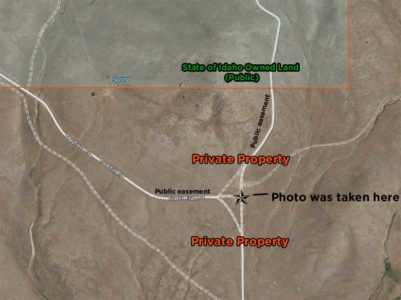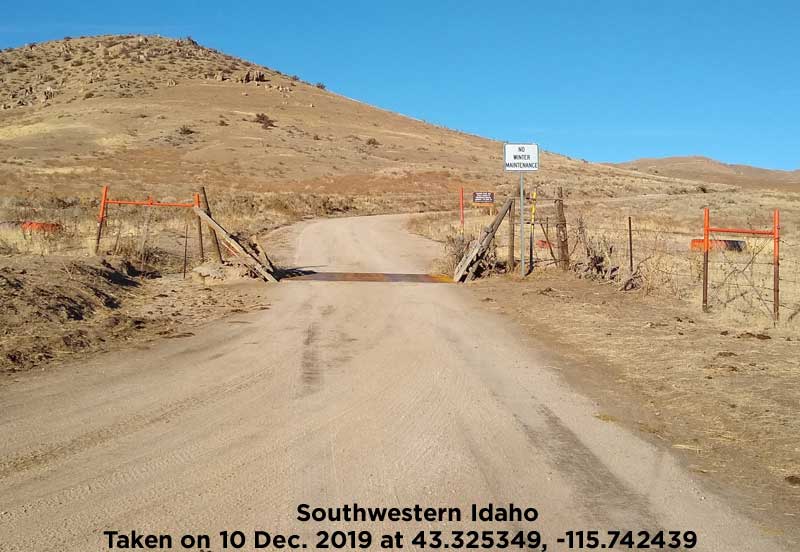(20 Dec. 2019 / Author: Tim Bondy) On 10 Dec. 2019, I headed up to the Danskin Mountains of southwestern Idaho. This is a backcountry drive I have taken many times in the past few years. That means I am very familiar with land ownership because I do my research so I don’t trespass. But when I come upon signage that might be designed to mislead or confuse people, I get a little annoyed. I believe the fence/gate markings at the intersection of Mayfield Road (Foothill Road) and Danskin Lookout Road (FSR #167) was done for the purpose of tricking citizen into thinking the road ahead is private property. I could be wrong about the landowner’s intentions.
About the Featured Image
- Taken On: 10 Dec. 2019
- Geotagged at 43.325349, -115.742439
- Map linked at https://goo.gl/maps/jDupUEKzyjV3dG3p9
- Link to Bigger Version: https://photos.app.goo.gl/f41WoVBbgDSHsdat8
Why I Believe Markings are Designed to Mislead
The photo clearly shows the blaze orange markings painted on the fence posts on either side of the cattle guard. That orange paint is what most people first see when approaching a backcountry intersection or fence line. And if the driver did some research into the land ownership, they would understand private property exists on both sides of that fence and cattle guard.

In this situation, there is a mixed message being presented to anyone unfamiliar with this specific area. The true road signs in the photo are government signage and one could infer that anyone can legally drive on the road to access public property further north. But …
In 2018, our Idaho legislature decided to tighten up trespassing laws and statues. That change in state code was rather contentious at the time because it made it very easy for landowners to charge citizens with trespassing even if the trespasser was unaware they were trespassing. At the same time, the legislature also decreased the landowner’s burden for marking their private property that they don’t want people on. Weird, huh?
The thing to know is the roads in this area have a public easement allowing the public to drive upon these roads. We should also understand that road maintenance is paid for by the taxpayers and not the private property owner. That maintenance would be rather costly for a large landowner such as in this situation. That tells me the private property owner is getting a significant benefit at the taxpayer’s expense.
Why do I think the blaze orange paint was meant to mislead? Because the private property owner’s orange markings are painted loud and proud on the posts, knowing full well there is an easement. Am I positive? Nope.
What is an Easement?
An easement is the right to cross or use someone else’s land for a specific purpose. The owner of the easement does not own the land, just the right to use it. The owner of the land may also use the area covered by the easement as long as they do not interfere unreasonably with the purpose of the easement.
For example, an easement for a buried gas line through a farm field typically does not prevent the landowner from farming over the gas line. Some easements may be used by the public generally while others are limited to specific individuals. Land that is burdened by an easement (i.e. the land over which the easement runs) is called the “servient estate” whereas land that is benefitted by an easement (such as land that is accessed by an easement) is called the “dominant estate.”
Source: https://www.racinelaw.net/easement-law.html /// Racine Olsen Attorneys in Boise and Pocatello, Idaho
Another Misleading Private Property Sign
In another case, I noticed a misleading private property sign on Foothills Road/Mayfield Road on 13 Nov. 2018. The private property owner used an old tire sign attached to the fence and abutting the cattle guard that states, “No Offroad Vehicles Next 10 Miles”

The difference between the first case of misleading signage and this sign is that there is no private property within three-quarters of a mile of that tire sign. In addition, the person posting the private property sign had no authority to tell the public they cannot drive offroad vehicles beyond that sign.
In my opinion, this is a case of an illegal sign designed to mislead people into thinking they cannot drive on this publicly maintained road.
Why would the Ditto Creek Ranch, LLC put up misleading signage? So their cattle wouldn’t be disturbed by vehicle traffic? That’s my guess, at least.
About the Tire Sign Photo
- Taken on 13 Nov. 2019
- Geotagged at 43.271089, -115.732883
- Map linked at https://goo.gl/maps/KBuKMgLL7T3JcXkv7
- Bigger Version: https://photos.app.goo.gl/FVVa48BV3AENp3aj6
Bondy’s Last Words
I’m almost as big of a private property proponent as I am a public property proponent, so when issues like misleading signage arise, I will speak up. Sometimes I speak up on social media and sometimes I head to the government for redress if it’s egregious enough. Today, I post on my Idaho Outdoor website because it’s important.
Just because the Idaho State Legislature doesn’t think that clear and proper communication is important, that doesn’t mean they shouldn’t be called out on the issue. It also means that any misleading private/public interface signage we come across should be brought to light because the State of Idaho won’t.
If property owners don’t want you on their lands, great. But the simplest solution is to clearly mark your land when there is a chance of miscommunication. As the two cases highlighted in this story show, the private property owners are either not doing their due diligence or are dishonest.
This whole issue regarding the public-private property interface is complex but it’s also stuffed full of unknowns and hard to find facts and information. Public easements in Idaho are quite difficult to learn about and even more difficult to find definitive guidance on when it comes to official rules and guidelines. This needs to change before citizens are charged with trespassing.
This story was originally published on 20 Dec. 2019.
Thanks,
~ signed ~
Tim Bondy
Freelance Writer & Citizen Journalist

